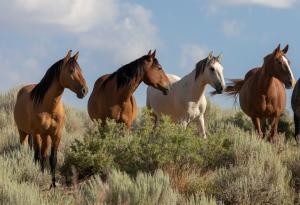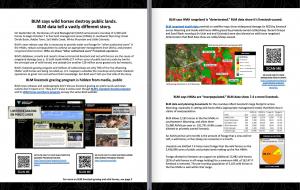Ongoing Wyoming Roundup is Expected to Become the Largest Wild Horse Removal in BLM Program History
Survey finds 69% of respondents contacted oppose the Wyoming wild horse removals.
ATLANTA, GEORGIA, UNITED STATES, November 11, 2021 /EINPresswire.com/ -- The Wyoming wild horse helicopter roundup is expected to become the largest removal in the Wild Horse and Burro Program history. The BLM November 10th update states 1,196 horses have been removed, 1 horse was returned to the range, and 6 horses have died.
Herd Management Areas, HMAs, are lands under BLM supervision that are to be managed for the primary benefit of free-roaming horses and burros.
History repeats itself. An article written August 11, 2011, ten years ago, called ‘The Quiet War Against Wyoming’s Wild Horses’ is an account of a past controversy over the horse’s ability to live in the same area. An excerpt from that article reads, “What strikes me about this story, however, is how little protection the wild horses of Wyoming really have, despite federal laws and regulations designed to protect them. What jolts me, too, is the strength and ferocity of the political forces arrayed against the horses. There are millions of acres upon which these horses can roam without materially interfering with livestock. There are hundreds of thousands of acres of such room in Sweetwater County alone.”
The Cowboy State Daily published an article on October 11th titled ‘Survey: Majority Of Americans Against Wyoming’s Wild Horse Roundup.’ The author reported “the poll found that 69% of respondents opposed removing all wild horses from 1.5 million acres of public lands in southern Wyoming to accommodate the oil/gas and livestock industries.”
The gather is being conducted to address the overpopulation on the HMAs, prevent deterioration of the rangeland due to the overpopulation, remove horses from private lands and areas not designated for their long-term use, and comply with the 2013 Consent Decree between the Rock Springs Grazing Association and the BLM.
Comparing the number of cattle to wild horse populations in the Western states, horses and burros have the lower population numbers. A Salt Lake Tribune article stated, “the current cow to horse ratio is 30 to 1. Within the BLM’s designated wild horse “herd management areas,” or HMAs, the ratio is about 9 to 1, depending on the time of year.” https://www.sltrib.com/news/environment/2021/09/24/report-blm-turns-blind
The BLM allows 2,165 horses on the 3,436,096 acres of public and private lands making up the five targeted HMAs. Horses are allotted 11.9% of the forage compared to the 88.1% allotted to livestock. If the land was used for its primary purpose, the wild horse population of 5,105 would be within the acceptable range. See Insert Above.
In a report prepared by P.E.E.R., Public Employees for Environmental Responsibility, addressing rangeland health, the following findings are presented.
“These figures are derived from BLM land health standards assessment datasets obtained through the Freedom of Information Act. The land health status records the most current assessment conducted through 2020.
• BLM’s records reveal that most of the allotments within HMAs that fail land health standards identify livestock as a significant cause of degradation of land health--approximately 11.5 million acres of the 21.5 million acres of allotments within HMAs assessed by BLM to date. Livestock is by far the most frequently identified cause of allotment failure to meet fundamental land health standards nation- wide, and for allotments within HMAs.
• BLM’s records also reveal that most of the area within HMAs that are within allotments failing to meet land health that identify livestock as a significant cause of degradation, also identify wild horses as a cause of land health degradation.
• Of the almost 22 million acres of HMA area within allotments that BLM has assessed, only a tiny fraction, 1%, 311,000 acres has been identified as failing due to wild horses alone, with no mention of livestock.”
Using this link, Wyoming can be viewed in Figure 2 Map. Areas in red show livestock only damage. BLM allotments assessed to date within HMAs are, allotments meeting all land health standards (green), allotments failing due to livestock and wild horses (orange), allotments failing due to wild horses without livestock (black), and those failing due to factors other than livestock or wild horses (yellow). https://peer.org/wp-content/uploads/2021/09/9-20-21-Onaqui-Mountain-HMA-Utah-wild-horse-material.pdf?eType=EmailBlastContent&eId=4a9db2dd-ddd1-4106-b930-0b359f54de26
Members of the public supporting wild horse protection continue calling on Congress to use taxpayer funding to maintain the range and keep the horses in their designated HMAs rather than spending the money on roundups and holding facilities. Supporters believe, if animal removals are necessary, the BLM should first remove livestock from HMAs, then provide the food and water resources necessary to maintain the horses that are the Federally designated primary beneficiaries of these lands.
Richard Nixon, Statement on Signing Bill To Protect Wild Horses and Burros.
https://www.presidency.ucsb.edu/documents/statement-signing-bill-protect-wild-horses-and-burros
From American Equine Awareness.
Donna Brorein, Advocacy News
American Equine Awareness
+1 770-870-7589
email us here
Legal Disclaimer:
EIN Presswire provides this news content "as is" without warranty of any kind. We do not accept any responsibility or liability for the accuracy, content, images, videos, licenses, completeness, legality, or reliability of the information contained in this article. If you have any complaints or copyright issues related to this article, kindly contact the author above.



